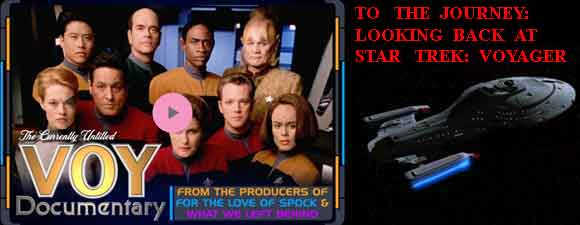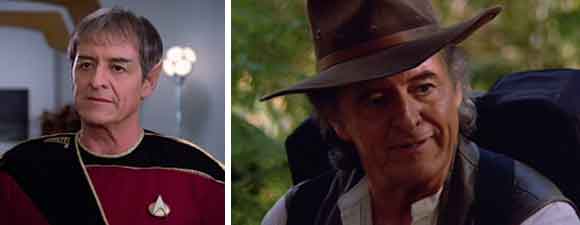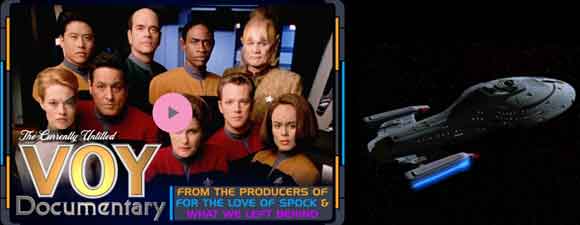Retro Review: Mortal Coil
6 min read
mortalcoilbanner
Neelix dies in a shuttle accident but is revived by Seven of Nine, who uses her nanoprobes to restore his vital signs.
Plot Summary: Having heard that Neelix has experience handling protomatter, Chakotay asks Neelix to assist when he and Paris go to retrieve some from a nebula. But the transport ignites the protomatter, causing an explosion that kills Neelix instantly. Hours later when Voyager rescues the shuttle, the Doctor explains that it is much too late to try to revive the Talaxian, but Seven of Nine disagrees, using her nanoprobes to restart Neelix’s synaptic functions and repair his cells. Though he has been preparing for a Talaxian family holiday called Prixin, Neelix finds his faith shaken because, while he was dead, he was not reunited with his loved ones in the Great Forest but experienced nothing at all. He begins to avoid his friends, even Naomi Wildman, who liked to hear his Talaxian stories at bedtime. With Chakotay’s help, he relives the shuttle accident and goes on a vision quest, but his visions show him his dead sister and his friends telling him that his life has no meaning. He decides to commit suicide by scattering his atoms into the protomatter nebula, but Kim discovers the transporter being activated and Chakotay goes to remind Neelix of how much his crewmembers value him – even Seven of Nine, who insisted on saving him because of his many skills. Though Neelix rejects the idea that Voyager’s family has replaced the Talaxian relatives he had expected to see again when he died, Samantha Wildman arrives to ask Neelix to help calm Naomi, who can’t fall asleep. Unwilling to traumatize the Wildmans by beaming himself into space while Samantha watches, Neelix goes to Naomi and decides that life is worth living no matter what happens after it ends.
Analysis: There’s a germ of a massively good story in “Mortal Coil” that’s at the core of many horror movies – the question of whether one should bring someone back from the dead just because one can. Spock is the extremely rare exception of a dead person brought back to life without terrible consequences; okay, David Marcus dies and the Enterprise blows up, but it’s not like Frankenstein, Pet Sematary, or The Lazarus Effect, where the results are catastrophic. Characters look taken aback when Seven announces that she can revive Neelix even though he’s already started to rot, but no one really argues the logical concern that Borg nanoprobes might not merely repair necrotized tissue but alter him in other ways, nor does anyone press the ethical question of whether this might constitute a violation of Talaxian beliefs the way the crew once violated a recently deceased young woman from “Emanations” (against Chakotay’s recommendation) for similarly selfish reasons: they thought she could tell them where Kim might have gone. While we’re all getting used to Seven of Nine’s massive amounts of screen time, perhaps it’s not the best choice to demonstrate yet again that she’s by far the most important person on the crew, since she can raise the dead. But once that choice has been made, how can it not come up every time a crewmember dies? Seven is right that Neelix serves diverse, important functions on board the ship, but pretty much everyone has family back home, and in upcoming episodes the Hirogen and other aliens kill several. What does it mean for the ship and indeed the Federation if Borg nanoprobes can reverse death? Can they also reverse aging? I have so many questions, yet the entire subject is dropped after “Mortal Coil” except when the Borg Queen holds out immortality as a seductive, evil offer that every reasonable Starfleet officer knows to avoid.
Ethan Phillips gives an extraordinary performance in what I must otherwise label a sad waste of an episode. I felt that way when I first saw it because of its lack of continuity with previous Voyager episodes about faith and death, and I feel even more so now, since we know Neelix’s crisis of faith will be resolved forever in a matter of moments, even though Chakotay warns repeatedly against the assumption that a single vision quest and its interpretation can satisfy a lifetime of spiritual beliefs and doubts. “Mortal Coil” shows us Neelix at his finest, demonstrating his value to numerous crewmembers as he goes about his day, and it is particularly pleasing to see both that he has a real friendship with Seven untroubled by her Borg past and that he is serving as a kindly uncle of sorts to quick-growing TV wonder baby Naomi, though it does surprise me that it isn’t a crewmember who misses his own children (Ayala, Carey, even Tuvok) to assume that paternal role. It’s even more surprising to learn that Neelix has experience with protomatter, the very substance responsible for bringing Spock back to life and destroying the Genesis planet, which aforementioned scientist David Marcus couldn’t control, though maybe both the Federation and Talaxians think they’ve made leaps in working with it since that era. In general during this episode, crewmembers step into roles that don’t particularly suit them while the logical people to do those jobs are left out. If Janeway wants to use such a volatile and deadly substance, wouldn’t it make sense to put engineer Torres on the shuttle? If Neelix is wounded, shouldn’t medical assistant Paris have more ideas for treating him than the first officer? If Seven’s nanoprobes can revive someone who has been dead for hours, why in heck didn’t she think to tell the Doctor about it during the (now-erased) Year of Hell, when she might have saved dozens of crewmembers?
Snarky comments about how the Borg didn’t find the Kazon worth assimilating may be meant as a slap to fans who liked those aliens, but they don’t make earlier seasons of the show go away, either. If Chakotay finally remembers that he has a medicine bundle, he should also remember that Ensign Kim died and was brought back to life in “Emanations” – an experience Kim might have discussed with Neelix as well as Janeway’s words about the mysteries of death when Kim was revived without the aid of Borg nanoprobes. We might also have heard some reference to Jetrel’s wish to try to bring back the victims of the Metreon Cascade and whether the Talaxian happy afterlife might have been a reason Neelix objected so strongly to helping him. We haven’t had nearly enough serious episodes about Neelix – four years on, he continues to be used primarily as comic relief – so rather than make brief mention of the atrocities that happened to his family and his long relationship with Kes, two things all longtime viewers of the show associate with him already, there’s a real opportunity to explore who he is and which aspects of his life have meant the most to him. What we get instead is a cobbled-together alien holiday that’s like a mash-up of New Year’s Eve, Bajor’s Gratitude Festival, and whatever friendship celebration Neelix put together in “Remember” for the Enarans – we’re told Janeway got drunk for Prixin the year before, which perhaps is why she’s been so uptight around her crew ever since. It doesn’t tell us anything unique about Talaxian culture and looks like a gratuitous excuse for the sort of Very Special Holiday Episode that Gene Roddenberry never would have approved. This isn’t quite It’s a Wonderful Life, since Neelix doesn’t get to see what the ship would be like if he’d never come aboard, but we still get to hear all about how essential he is around his psychological trip to the afterlife. Apparently people in such quests look and talk like Bajor’s Prophets, so maybe all of Star Trek is a Benny Russell vision.






